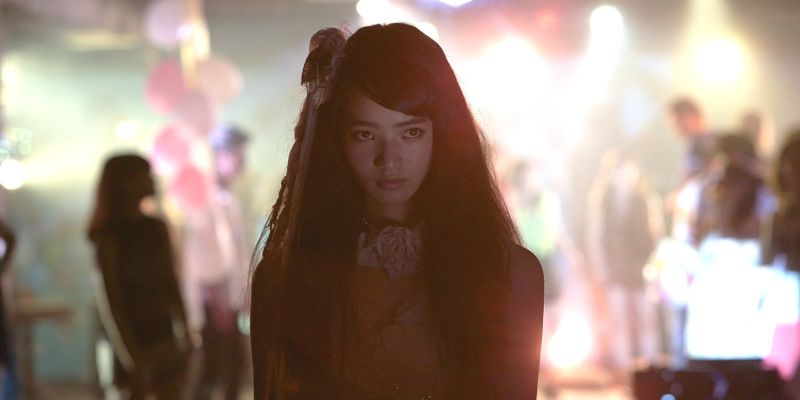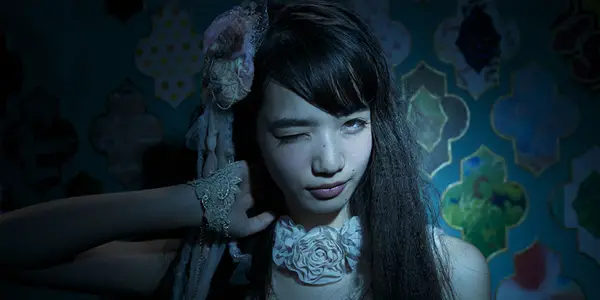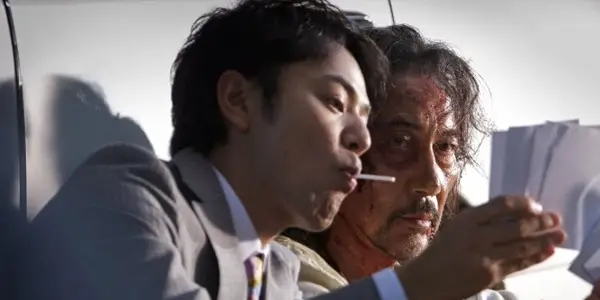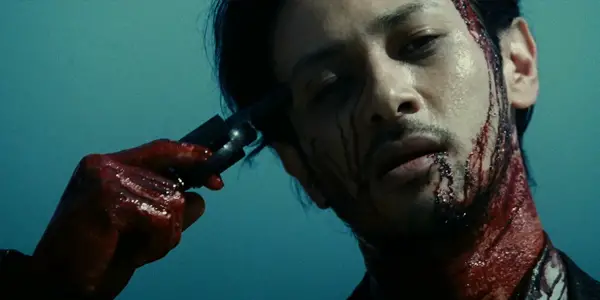THE WORLD OF KANAKO: A Brilliant Gut Punch To Noir

Alex is a 28 year-old West Australian who has a…
To try and properly describe The World of Kanako is quite a tough feat. So far I have a mix of the youth-filled slaughter of Battle Royale, the rapid-fire non-linear editing of John Boorman’s Point Blank, and the grittiness of Sam Peckinpah’s Bring Me the Head of Alfredo Garcia, smashed together in a blood soaked blender and left to sit in the sun.
The World of Kanako is a brutal, convoluted and pop-culture infused neo-noir which punctures a bandage-wrapped fist in the face of decency in delivering its twisted story. For these reasons, and more – I absolutely loved it.
I Don’t Like That Man On-Screen
The World of Kanako seriously challenges the audience’s limits when it comes to engaging with the characters on-screen – if every single person (save for some innocent female side characters) are complete degenerates, especially our main protagonist, then why are we watching? The protagonist, Akikazu (Kôji Yakusho), is a violent, abusive drunk who throughout the film kills, assaults and rapes people frequently in his quest to track down his missing daughter. So why should we care if he finds her or not? Well, without spoiling anything, the film sets up why him meeting his daughter is something that we slowly anticipate.
Director Tetsuya Nakashima twists the story in an erratic non-linear fashion which makes past events into legitimate twists, revealing character motivations and events at key times that don’t feel cheap or unnecessary, but instead are properly planned out reveals which makes sure the film never gets boring or predictable.

The idea of the unlikable protagonist isn’t a popular one for audiences, shown by the negative reactions to films like Martin Scorsese’s The Wolf of Wall Street and lately Quentin Tarantino’s The Hateful Eight. Both films used heinous protagonists to make larger political points, using their narrative in order to address the film’s moralistic demands.
Whilst The World of Kanako doesn’t delve quite as deep thematically as those films, it is worth understanding that sometimes films don’t feature a main character who is a moral centre – a filmmaking decision which people seem to confuse with bad writing or hateful characterisation. This can lead to people often mistaking their conjured feelings for anger towards the filmmaker/actor, rather than what the film itself is saying.
When Narrative Meets Form
The World of Kanako juggles roughly about four different timelines at once, which can make for some frequently confusing or convoluted storytelling. This isn’t a film that you can watch with Twitter open whilst lazily relaying your banal thoughts – it demands you pay attention. The main timeline focuses on Akikazu Fujishima, a complete mess of a man, an alcoholic ex-cop who is estranged from his family, which includes his ever-suffering wife and his mysterious teenage daughter, the titular Kanako (Nana Komatsu).
After a bloodbath at a local deli that leaves three people dead, low-level security guard Akikazu is seen as the lead suspect due to being the one who first found the bodies. As this is happening, his ex-wife reluctantly gets his help to find Kanako, who has been missing for five days with zero communication. Akikazu’s investigation has him investigating the life of his daughter, slowly finding out who she is and what she has done to cause the ire of so many people around her. These small revelations start to slowly horrify Akikazu as his study gets him caught in the middle of a horrific Yakuza war between the mafia and a band of corrupt cops.

The most noticeable choice in The World of Kanako is the volatile editing, which not only organizes the film’s constantly shifting timelines around, but also adds to its pop-infused charm, which harks back to the films of Seijin Suzuki and Takashi Miike. Whilst the film frequently shows acts of brutal violence, Nakashima carefully constructs his shots and edits them in a way which never revel in the nastiness of the brutality, substituting the bloodshed with jump-scare type title cards which flash a comic-book styled blood splatter whenever heavy violence is inflicted on-screen.
This decision not only looks good aesthetically, giving the film some originality, but it removes the cruelty from the film-watching experience. Hiding the violence creatively not only allows the audience to let their imagination fill in the gaps (a tactic of most great horror films), but it never gets so sleazy that it adds to the detriment of viewing it. Whilst you might be shocked by the violence, the film understands that the acts are appalling and doesn’t languish in it, which is what a lesser director would’ve done for the sake of cheap shock tactics and an attempt to leave a lingering memory for the audience, rather than by great directing or creating memorable characters.
Another great comic-book style aesthetic that is introduced is the old school grindhouse styled opening title card sequence, which intercuts graphics which scream ‘FUCK’ and ‘LOVE’, two extremes which the film bounces between, visually and thematically – moments of shocking violence mixed with ones of tender sentiments. It is a title card sequence that mixes the iconic visuals of Saul Bass with the gory aesthetic of Herschell Gordon Lewis, letting the audience know initially of its black comedic tone, which helps ease them into the darker plot elements.
The continually shuffling pop soundtrack keeps the film pulsating, with the music as erratic as the visuals on-screen. The soundtrack is similar to that of Seijin Suzuki’s delightful pop-culture infused crime dramas, such as Youth of the Beast and Branded To Kill. The mix of Japanese and Western pop-music makes sure the soundtrack never gets old and repetitive, as it is always steadily moving on to the next song, to keep up with the film’s rapid style of storytelling.
Giving It Your All
Kôji Yakusho gives the film its all, and part of its success is anchored on his enthusiastic performance. Yakusho is an actor best known for his starring performance in the international hit Shall We Dance?, where he subverted his frequent roles as a good-looking samurai and played a weathered businessman turned dancer in a dedicated portrayal. Yakusho once again sheds his good-guy image, giving life to the completely atrocious Akikazu, managing to make the character a living and breathing person that despite his awful nature, we want to see what he does next. His despondent gruff rendition of Akikazu is a hard one to pull off, one which requires a subtle mix of savagery and sorrow, whilst being engaging to watch onscreen.
Nana Komatsu’s portrayal of the titular Kanako is done in an extremely smart way – whilst her father portrays brutality in an outlandish and spectacular fashion, Komatsu shows us an opposite way to get there, using innocence and purity to corrupt those around her. Komatsu’s quiet but powerful performance demonstrates one of the main thematic points that Nakashima is trying to make – that true evil comes from manipulating and destroying those that we love, rather than random acts of violence to those we don’t know.
Aside from this, the film’s co-stars are constantly rotating due to its fast-paced nature and regularly altered narrative. Other great performances include Hiroya Shimizu as “I”, the unnamed bullying victim whose journey into the corruption of Kanako coincides with that of Akikazu’s, and Asuka Kurosawa as Kiriko, the beaten ex-wife of Akikazu and one of the only innocent characters in the film.

My criticisms towards The World of Kanako are quite minimal, and when writing them out, seem to be very nit-picky in nature. The film constantly brings up the famous story of Alice in Wonderland, relating Alice’s crazy descent into the dream-like world of Wonderland juxtaposed with Akikazu’s cynical slide into Kanako’s messed up lifestyle. Whilst it is a fair comparison, it is one that is ham-fisted repeatedly in the film, when the audience already gets the point that Nakashima is trying to make. Whilst most of the film itself isn’t subtle due to its violent nature, the attempt to create thematic depth by constantly referring to Alice in Wonderland grows tiring as it goes on.
The two-hour runtime also drags the film longer than it needs to be, with some bridging filler scenes (repeated scenes of partying and already established character actions looped) beefing it out longer than it really needs to be. I could see some people finding this quite grating due to the extended run-time, when overall the movie is telling a deconstructed noir tale, not an epic drama that demands a ton of screen-time to work.
The Verdict
The World of Kanako is an exhilarating grim noir tale and the product of many volatile influences, ranging from the erratic nature of Sion Sono’s films to the misanthropic violent visuals of Sam Peckinpah’s best movies. The film manages to pull off the somewhat impossible – juggling four different timelines which only occasionally intersect and still tell a compelling and genuinely gripping story. Thanks to the constantly shifting cinematography and captivating pop-centric soundtrack, the film maintains its bombastic energy throughout its lengthy two-hour run-time.
Whilst not a film for everyone due to its extremely nihilistic attitude and frequent bouts of physical and sexual violence, The World of Kanako is a must-see for any fans of off-beat cinema, and for those who are sick of the constant parade of PG-13 cinema that dominates most mainstream cinemas. The World of Kanako is a film that demonstrates that violence and noir stories can still be incredibly effective in a sea of minor archetypes – it’s all up to how a filmmaker decides to tell their story – and here, Tetsuya Nakashima told a damn good one.
What are some other subversive genre films that have really impressed you lately?
Does content like this matter to you?
Become a Member and support film journalism. Unlock access to all of Film Inquiry`s great articles. Join a community of like-minded readers who are passionate about cinema - get access to our private members Network, give back to independent filmmakers, and more.













